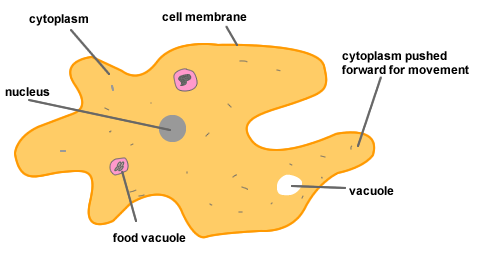Definition
Protozoa are a diverse group of unicellular eukaryotic organisms, many of which are motile. Originally. protozoa had been defined as unicellular protists with animal-like behavior. e.g. movement. While there is no exact definition for the term protozoa, it often refers to a unicellular heterotrophic protist, such as the amoeba and ciliates.

Protozoa commonly range from 10 to 52 micrometers. but can grow as large as 1 mm, and are seen easily by microscope. The largest protozoa known are the deep-sea dwelling xenophyophores, which can grow up to 20 cm in diameter.
Protozoa exist throughout aqueous environments and soil, occupying a range of trophic levels They move around with whip-like tails called flagella, hair-like structures called cilia. or foot-like structures called pseudopodia. Others do not move at all. Protozoa may absorb food via their cell membranes. some, e.g., amoebas, surround food and engulf it, and yet others have openings or “mouth pores” into which they sweep food.
Classes of protozoa –
Protozoa are classified into three classes as follows –
a) Filagellates –Flagellates are the smallest members of the protozoa group. These are found mostly in soil and flagellates that contain chlorophyll typically occur in aquatic conditions. Flagellates can be distinguished by their flagella, which is their means of movement. Some have several flagella, and other species only have one,
b) Amoebae –Amoebae are larger than flagellates and move in a different way. Amoebae can be distinguished from other protozoa by their slug-like properties and pseudopodia. A pseudopodia or “false foot” is a temporary obtrusion from the body of the Amoebae that helps pull it along surfaces for movement or helps to pull in food.
c) Ciliates –Ciliates are the largest of the protozoa group and move by means of short. numerous cilia that produce beating movements. Cilia resemble small, short hairs, and they can move in different directions to propel the organism in a different direction, giving it more mobility than flagellates or amoebae.
Ecological role
a) Food source –As components of the micro-and meiofauna, protozoa are an important food source for micro invertebrates.
b) Ecological role –The ecological role of protozoa in the transfer of bacterial and algal production to successive trophic levels is important. As predators, they prey upon unicellular or filamentous algae. bacteria, and microfungi. Protozoa are both herbivores and consumers in the decomposer link of the food chain. They also control bacteria populations.
c) Pathogens –Protozoa such as the malarial parasites (Plasmodium spp.), trypanosomes and leishmania, amoebae are parasites causing diseases in humans and plants.
d) Symbionts –Protozoa are symbionts in multicellular animals.
